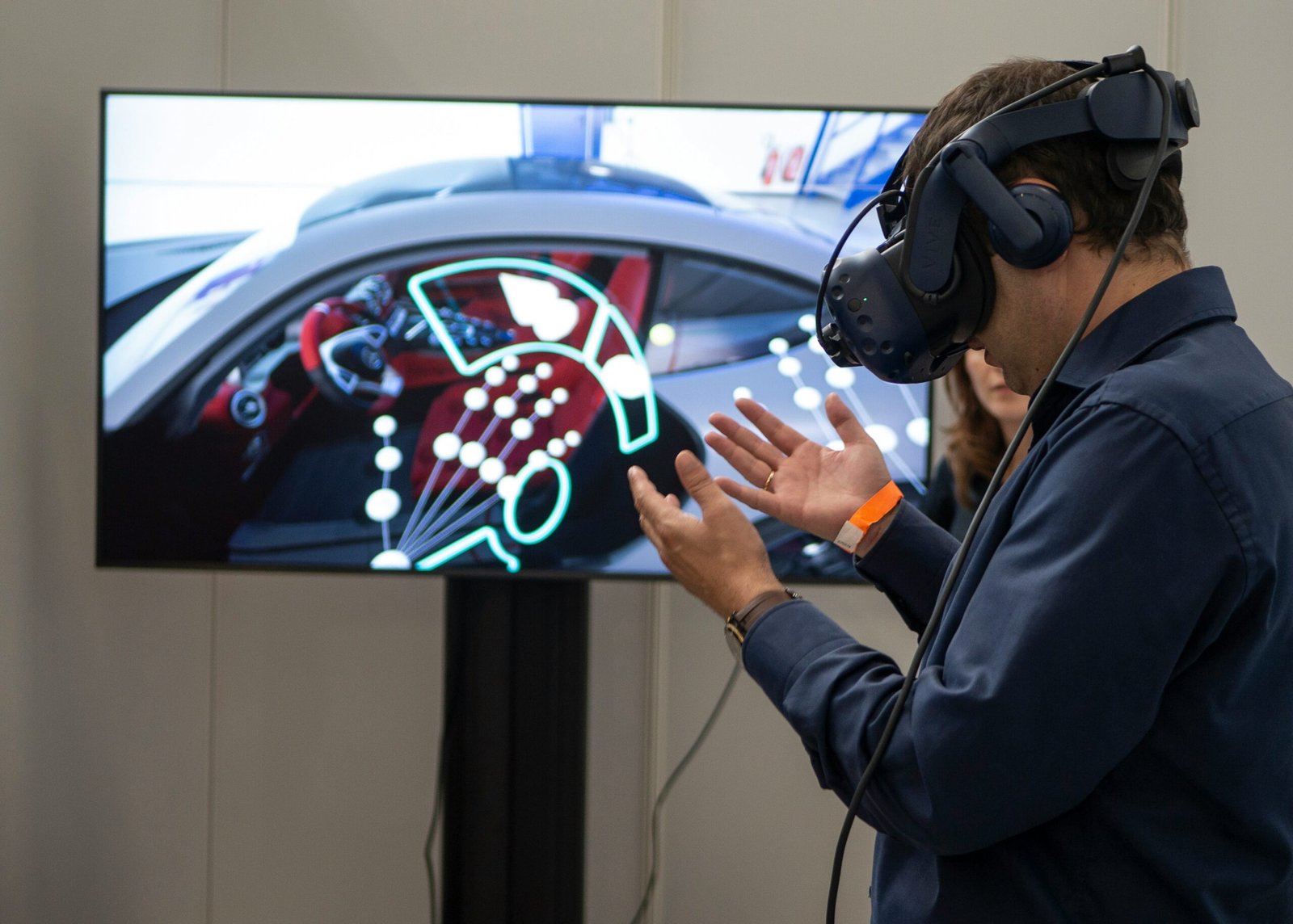Biohacking: Ready to Upgrade Your Body?
 Photo by Scott Graham on Unsplash
Photo by Scott Graham on Unsplash Introduction to Biohacking
Biohacking, often referred to as the DIY biology movement, encompasses a wide range of practices aimed at enhancing human performance and optimizing health through scientific principles and personal experimentation. The term has its origins in the early 2000s, emerging as a response to the advancements in biotechnology and the increasing accessibility of scientific tools. As society has become more attuned to the capabilities of technology, biohacking has evolved into a multifaceted endeavor appealing to wellness enthusiasts, entrepreneurs, and scientists alike.
At its core, biohacking embodies the principles of self-experimentation and personal optimization. Individuals seek improvement in their physical and mental capabilities, often through various methods, including dietary changes, exercise regimens, and the integration of technology. The core belief driving biohacking is that everyone possesses the potential to optimize their bodies, and this can be achieved through informed practices and tailored adjustments to one’s lifestyle.
There are several approaches to biohacking, reflecting the diversity of individuals’ goals and backgrounds. Nutritional interventions, such as adopting ketogenic or intermittent fasting diets, are popular means by which enthusiasts seek to bolster energy levels and cognitive clarity. Similarly, the incorporation of technology, including wearable devices that track biometrics, allows individuals to gain real-time feedback on their health metrics, facilitating informed decisions about their well-being.
Additionally, lifestyle adjustments such as sleep optimization techniques and mindfulness practices have emerged as essential components of this movement. Each biohacking method shares a common aim: to enhance the human experience through systematic experimentation and optimization. As the field continues to grow, it provides opportunities for further exploration into the science behind personal health enhancement.
The Science Behind Biohacking
Biohacking emerges from an intricate understanding of human biology, grounded in the principles of biochemistry and physiology. At its core, this practice seeks to optimize physical and mental performance through various interventions that influence biological mechanisms. Understanding how our bodies function at a cellular level is crucial to these techniques, as it provides insights into how specific changes can enhance overall health.
The biological significance of biohacking lies in its ability to modify gene expression, enhance cellular function, and optimize metabolic pathways. For instance, nutritional biohacking often entails manipulating dietary components to achieve specific health outcomes. Studies illustrate that a ketogenic diet can alter the body’s energy utilization, shifting from glucose to ketones, which may contribute to improved cognitive function and enhanced endurance during physical activities. Additionally, intermittent fasting has been shown to stimulate autophagy, a process that assists in cellular repair and rejuvenation.
Another essential aspect of biohacking is the role of external factors, such as technology, environment, and lifestyle choices, in influencing biological outcomes. Wearable devices allow individuals to track various biometric data, providing insights into heart rate variability, sleep patterns, and physical activity. Research supports that consistent monitoring of these metrics can lead to improved health behaviors and awareness of personal well-being. Furthermore, techniques such as cold exposure and breathwork have gained traction for their purported benefits in reducing inflammation and enhancing mental clarity, respectively.
Scientific studies continue to validate several biohacking methods. For example, a researched method known as neurofeedback shows promise in enhancing cognitive function by providing real-time feedback on brain activity, enabling users to train their brain to achieve desired states of focus or relaxation. As biohacking evolves, it is paramount to approach these methods with a critical lens, emphasizing evidence-based practices to ensure safety and effectiveness in optimizing human potential.
Popular Biohacking Techniques
Biohacking encompasses a range of techniques designed to enhance physical and mental performance. One of the most widely adopted methods is intermittent fasting, which involves cycling between periods of eating and fasting. This approach not only aids weight management but also has been associated with improved metabolic health and increased longevity by promoting cellular repair processes and reducing inflammation.
Nootropics, often referred to as “smart drugs,” represent another popular biohacking technique. These compounds are utilized to enhance cognitive function, memory, and creativity. Common nootropics include substances like caffeine, L-theanine, and racetams. Users often report improvements in focus, mental clarity, and overall brain health, making nootropics appealing for those engaged in demanding mental tasks or seeking to boost productivity.
Meditation is a technique that has gained recognition for its positive impact on mental well-being. Regular practice can lead to reduced stress, enhanced emotional health, and improved focus. Mindfulness meditation, in particular, encourages individuals to concentrate on the present moment, fostering a deep sense of relaxation and clarity. With the increasing pace of modern life, many individuals find that meditation serves as an essential coping mechanism, allowing for improved emotional resilience and mental clarity.
Sleep hacking, another prominent biohacking practice, involves optimizing one’s sleep environment and routines to enhance sleep quality. Techniques such as maintaining a sleep schedule, minimizing screen time before bed, and utilizing sleep-tracking devices can significantly improve restorative sleep. Ensuring adequate sleep is crucial for physical recovery and cognitive function, making this practice invaluable for anyone looking to boost their overall health.
Lastly, physical training methods such as high-intensity interval training (HIIT) and strength training are integral components of biohacking. These approaches focus on maximizing workout efficiency and can lead to significant improvements in physical performance, muscle growth, and fat loss. By systematically manipulating workout intensity and recovery, individuals can optimize their fitness outcomes effectively.
The Role of Nutrition in Biohacking
Nutritional biohacking stands as a fundamental pillar in the quest for health optimization. Through the deliberate manipulation of diet and nutrient intake, individuals can significantly influence their bodily functions, enhance mental clarity, and improve overall physical performance. A well-structured nutritional plan is essential for those seeking to unlock their full potential and achieve their health goals.
Various diet strategies have gained prominence in the biohacking community. The ketogenic diet, for instance, emphasizes high-fat and low-carbohydrate intake, prompting the body to enter a state of ketosis. This metabolic state can lead to improved energy levels and cognitive function. By focusing on fats as the primary energy source, practitioners may experience enhanced mental clarity, which is a crucial aspect of biohacking.
On the other hand, the paleo diet encourages consumption of whole, unprocessed foods similar to what our ancestors would have eaten. Emphasizing meats, fish, fruits, and vegetables while avoiding grains and legumes, this approach can lead to improved digestion and nutrient absorption. Biohackers often report enhanced energy levels and better overall health when adhering to this historical dietary framework.
Another diet gaining traction within biohacking is the plant-based diet, which focuses on fruits, vegetables, whole grains, and legumes. This dietary pattern is rich in essential micronutrients, which play a pivotal role in maintaining optimal health. Adequate micronutrient intake is vital for various bodily functions, from energy production to immune support. Furthermore, micronutrients can aid in reducing inflammation and improve recovery time, critical factors for those engaged in rigorous physical activities.
Supplementation and hydration are also integral components of nutritional biohacking. By complementing their diets with specific vitamins, minerals, and hydration strategies, individuals can further fine-tune their bodily functions. In conclusion, understanding and implementing effective dietary practices is essential for anyone looking to enhance their health and performance through biohacking.
Technology and Biohacking: Wearables and Beyond
The integration of technology into the realm of biohacking has engendered significant advancements in personal health management. Various devices and applications are now at the disposal of biohackers, allowing them to track, analyze, and optimize their physical and mental performance. Among these technological tools, fitness trackers have emerged as indispensable companions for anyone looking to improve their health. These gadgets monitor key metrics such as steps taken, heart rate, and caloric expenditure, providing valuable insights that can guide lifestyle adjustments.
In addition to fitness trackers, sleep monitors have gained popularity as biohacking tools designed to enhance the quality of rest. By continuously monitoring sleep patterns, these devices can help users identify disturbances in their sleep cycle and suggest changes to improve sleep efficiency. Similarly, continuous glucose sensors represent a groundbreaking advancement; they enable biohackers to maintain real-time awareness of their glucose levels. This data can influence dietary choices and optimize energy levels throughout the day.
Another significant leap in biohacking technology is represented by genetic testing kits. These kits allow individuals to gain insights into their genetic predispositions, thereby informing tailored health and wellness strategies based on their unique genetic profiles. As technology progresses, biohackers are also beginning to explore emerging fields such as neurofeedback and personalized medicine. Neurofeedback utilizes real-time displays of brain activity to facilitate self-regulation of brain functions, potentially leading to improved cognitive performance.
Moreover, personalized medicine promises to revolutionize biohacking by offering treatments and lifestyle recommendations based on individual genetic and physiological data. This convergence of technology and biology represents a transformative era for biohackers, enabling them to take control of their health in innovative ways that were previously unimaginable. As we continue to explore these advancements, it becomes evident that the future of biohacking is deeply intertwined with the evolution of technology.
The Ethical Considerations of Biohacking
As biohacking continues to gain traction among individuals seeking to enhance their physical and cognitive capabilities, ethical concerns emerge as a pivotal topic of discussion. One significant issue is the safety of self-experimentation. Many biohackers engage in practices that may lack sufficient scientific backing, putting themselves at risk for adverse health effects. It is crucial for individuals to conduct thorough research and consider the possible consequences before embarking on self-directed experimentation. The absence of regulation in this area means that many biohackers operate outside of established medical protocols, which can lead to unforeseen complications.
Another critical ethical consideration is the implications of altering one’s biology. While technological advancements provide individuals with the opportunity to optimize their health, they also raise questions about the definition of what it means to be human. The potential for self-enhancement can lead to a variety of social implications, such as the perception of individuals who choose not to engage in biohacking. Moreover, society may grapple with the moral ramifications of using technology to augment natural abilities, leading to debates on what constitutes fairness and equality in various aspects of life.
Access to biohacking resources is another area of concern, as disparities in health care may exacerbate existing inequalities. Individuals with greater financial means may have access to advanced biohacking tools and technologies, while those from lower socioeconomic backgrounds may lack the opportunity to benefit from such methods. This disparity creates an ethical dilemma, as biohacking could potentially widen the gap in health outcomes based on socioeconomic status. Therefore, biohackers bear a responsibility not only to their personal health choices but also to the broader community, emphasizing the necessity of informed decision-making. Engaging in biohacking should involve careful consideration of its ethical implications and a commitment to promoting equity in health access.
Case Studies: Success Stories in Biohacking
Biohacking has gained significant traction in recent years, manifesting through numerous success stories that exemplify how individuals have taken control of their health and enhanced their performance. One notable case is that of Dave Asprey, the founder of Bulletproof Coffee. Asprey embarked on a journey of self-experimentation, seeking to optimize his cognitive function and overall well-being. By combining a high-fat, low-carb diet with supplements and specific biohacking tools, he reported a substantial increase in his energy levels and mental clarity. His transformation not only led him to lose over 100 pounds but also inspired a community of followers dedicated to the Bulletproof lifestyle.
Another compelling story comes from Tim Ferriss, who documented his biohacking journey through the acclaimed book “The 4-Hour Body.” Ferriss experimented with various techniques, including slow-carb dieting, minimal effective doses of exercise, and sleep optimization strategies. Through meticulous tracking and experimentation, he achieved remarkable results such as significant fat loss and muscle gain, all while minimizing time spent on traditional fitness regimens. His case illustrates the power of self-quantification as an essential aspect of biohacking.
Furthermore, the use of cold exposure has proven effective in biohacking endeavors, as evidenced by the experiences of Wim Hof, known as “The Iceman.” Hof developed a unique breathing technique combined with cold exposure to enhance physical and mental resilience. Participants in his workshops have reported reduced anxiety levels, improved mood, and enhanced immune function, showcasing the therapeutic benefits of biohacking methods.
These case studies signify the diverse approaches within the biohacking community, highlighting the potential for individuals to achieve transformative health benefits by experimenting with tailored strategies. By sharing these success stories, readers can glean insights and motivation to embark on their biohacking journeys, embracing the possibilities of unlocking their full potential.
Getting Started with Biohacking
Embarking on a biohacking journey can be both exciting and overwhelming. To ensure a successful start, it is essential to establish clear and measurable goals. Begin by identifying specific areas of your health or performance you wish to enhance, such as energy levels, cognitive function, or physical strength. By defining your objectives, you can tailor your biohacking efforts to achieve meaningful results.
Next, selecting the right tools and techniques is crucial. Biohacking encompasses a wide range of methods, from dietary changes and exercise regimens to supplementation and advanced technologies like wearables. Research and experiment with various tools to discover what resonates with you. For instance, a popular starting point is tracking sleep quality through devices or apps, while others might find value in monitoring their nutrient intake using food journals. The choice of method should align with your goals and be sustainable in the long run.
Implementing changes gradually is a vital aspect of successful biohacking. Instead of overwhelming your system with multiple changes, approach your biohacking journey in small, manageable steps. Introduce one new technique or tool at a time, allowing your body to adjust before adding another. This gradual implementation not only aids in acclimatization but also helps you identify what works best for your individual needs.
Tracking your progress is important as it allows for adjustments based on your responses. Utilize journals, apps, or spreadsheets to monitor changes in your health or performance metrics. Regularly assessing your data can provide insights into what methods are most effective and highlight areas that may require modification. Remember, biohacking is a personal journey, and tailoring your approach to align with your body’s feedback is essential for achieving your desired outcomes.
Conclusion: The Future of Biohacking
As we navigate through the evolving landscape of biohacking, it is evident that advancements in technology are ushering in a new era of personalized health and wellness. This movement, which encompasses a wide range of practices aimed at optimizing the body’s performance and enhancing overall well-being, is gaining traction among individuals seeking greater control over their health. Emerging technologies, such as wearable devices, genetic testing, and artificial intelligence, are set to reshape the way we approach health diagnostics and interventions, making biohacking more accessible and effective than ever.
The future of biohacking is not without its challenges. As we delve deeper into genetic modification and the manipulation of biological processes, it becomes increasingly important to consider ethical implications. There is a need for responsible exploration of these techniques to prevent potential societal discord or unintended consequences that could arise from widespread biohacking practices. Therefore, establishing guidelines and ethical standards will be crucial in ensuring that the benefits of biohacking are realized without compromising individual rights or societal values.
Additionally, the shift towards personalization in health management signifies a broader paradigm change in our understanding of wellness. Rather than a one-size-fits-all approach, biohacking encourages individuals to adopt tailored strategies that fit their unique physiological and psychological profiles. This trend suggests a growing recognition of the importance of individual agency in health decisions, which could empower many to take proactive steps towards achieving their optimal state of health.
In closing, as we stand on the precipice of these advancements, it is imperative for readers to engage with biohacking thoughtfully. Exploring this exciting field can open doors to innovative health solutions, yet it must be undertaken with mindfulness and a commitment to ethical practices. By doing so, individuals not only enhance their own health journey but also contribute positively to the larger conversations surrounding the future of health and technology.



Tidak ada komentar